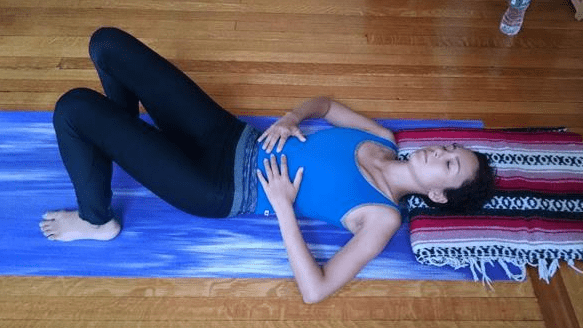You make it to yoga class, and by the end that, all stiffness and minor pain in your body is lessened, and you feel so much better in many aspects of your being. The next day at work, however, that nagging physical discomfort or pain creeps back. Maybe it’s in your neck and shoulders, maybe it’s in your knees, or perhaps it’s in your hips.
So how do you address nagging pains and stiffness? Easy answer – Constructive Resting Pose.
Construction Resting Pose targets the root of the problem of nagging minor aches and pains, and does so much more. It lets you start your practice, or move forward with your day, with less disorganization in your posture in the first place.
Some Benefits of Constructive Resting Pose
(Or enhanced semi-supine position)
-
It takes about 20 minutes for the discs between each vertebrae of your spine to re-hydrate, allowing your spine to expand naturally and effortlessly.
-
While you lie down doing “nothing”, you let your body, the floor and gravity work together to reorganize your posture, that is, your skeleton, muscles and even fascia, as they have the opportunity to relax at a deeper level.
-
Your organs reclaim their full space to function more efficiently. (Did you know postural habits can pressurize and disorganize your internal organs?)
-
Your entire nervous system and your muscle tone rebalance themselves and leave you calmer, centered and with a more efficient body.
-
It’s a chance to observe what your body is doing. You may be surprised at how much muscular tension you subconsciously hold as you experience the releases and openings in many parts of your body that you didn’t know could release further.
How To Do Constructive Resting Pose
It’s helpful to have your pose supervised the first handful of times, so practicing it with Coach Sara or a qualified Alexander Technique-based teacher is recommended.
-
Lie on your back on a firm surface. Prop the back of your head up with a folded blanket, towel, etc. Make sure the propping does not make you compress your throat or the back of your neck. Make sure your face is parallel to the ceiling and that your knees are in your vision field while you stay relaxed.
-
Bring your knees toward your chest and hold your knees in the palms of your hands. Take a few breaths breathing all the air out before you naturally inhale again.
-
One by one, let go all control of your leg and hips and let your foot plop down flat on the mat/floor. Let go all control of your other leg and hips to let your other foot plop where it does on the mat/floor.
-
If your knees want to splay out, rotate your heels away from each other. If your knees want to fall towards each other, rotate your heels closer to each other.
-
Bring your hands to rest on your torso with elbows bent.
-
Take 10 breaths, exhaling all the CO2 out completely. Allow your weight to release into the support of the floor, through all parts of you in contact with the floor.
-
Congrats, you’re now in Constructive Resting Pose!
-
Don’t try to do anything. Just let yourself be. This is a being experience to balance out all the doing we engage in all day. It has a meditative quality to it, and your back and whole body are totally supported by the floor.
Enjoy! By undoing habits of holding through Constructive Resting Pose before Yoga class or as a break during your day, you are re-calibrating your nervous system, particularly your subconscious brain. You have begun to unlearn less than optimal habitual ways of moving, all by letting go and observing, and starting to say goodbye to those daily nagging aches and pains.
Sources:
Cecile Raynor, amSAT. Yoga Teacher Coach. alexandertec.com.
Moore, David. “Yoga & the Alexander Technique” pg. 124-129. 2015.
How useful was this post?
Click on a star to rate it!
Average rating 4.8 / 5. Vote count: 4
No votes so far! Be the first to rate this post.



